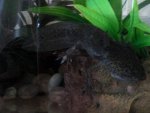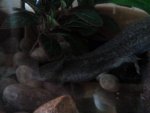sarah13
New member
- Joined
- Apr 25, 2011
- Messages
- 4
- Reaction score
- 0
- Points
- 0
- Country
- United Kingdom
I have had my axolotl for five months and I think he has lots of problems. He is in a 48 litre tank with large pebbles (much too big for him to swallow). I do a partial water change every week and treat the water to remove chlorine. The filter also has a spray bar to reduce water flow.
Ever since I’ve had him he has never eaten much and been very fussy. He refuses to eat earthworms and spits them out even when I cut them up, so I have to feed him bloodworms, chicken and daphnia. I am aware that this is not nutritious for him but he will not eat anything else.
He has now stopped eating all together which I think is due to heat stress. We had a spell of hot weather and I did not realise how warm the tank was. It is now at a suitable temp but he is still stressed. My axolotl looks very underweight now and his back end floats up sometimes, I am not sure if this is a symptom of heat stress or something else.
I have also notices a change in his gills, they look less fluffy, he is now taking very frequent trips to the surface for air and also moving the gills a lot. There is enough oxygen in the water because I have an air stone and I think the filter puts oxygen into the water too. I have never kept him with fish.
I am very worried about my axolotl and although the heat stress was entirely my fault I cannot see how the other problems have occurred as I have tried my best to look after him properly. I’m starting to think about how healthy he was when I brought him because of his extremely small appetite but I may be wrong.
Please help me, I don’t know what to do anymore and I don’t want him to die. I will test the water soon, it is usually always fine and I will also try and take some pics but they don’t usually come out very good. Sorry this was so long but I wanted to explain as much as possible. Thanks Sarah.
Ever since I’ve had him he has never eaten much and been very fussy. He refuses to eat earthworms and spits them out even when I cut them up, so I have to feed him bloodworms, chicken and daphnia. I am aware that this is not nutritious for him but he will not eat anything else.
He has now stopped eating all together which I think is due to heat stress. We had a spell of hot weather and I did not realise how warm the tank was. It is now at a suitable temp but he is still stressed. My axolotl looks very underweight now and his back end floats up sometimes, I am not sure if this is a symptom of heat stress or something else.
I have also notices a change in his gills, they look less fluffy, he is now taking very frequent trips to the surface for air and also moving the gills a lot. There is enough oxygen in the water because I have an air stone and I think the filter puts oxygen into the water too. I have never kept him with fish.
I am very worried about my axolotl and although the heat stress was entirely my fault I cannot see how the other problems have occurred as I have tried my best to look after him properly. I’m starting to think about how healthy he was when I brought him because of his extremely small appetite but I may be wrong.
Please help me, I don’t know what to do anymore and I don’t want him to die. I will test the water soon, it is usually always fine and I will also try and take some pics but they don’t usually come out very good. Sorry this was so long but I wanted to explain as much as possible. Thanks Sarah.
Last edited:



